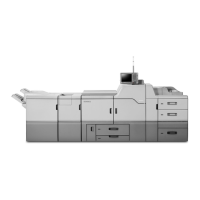7. Enhanced Network Security
This chapter describes how to increase security over the network using the machine's functions.
Preventing Unauthorized Access
You can limit IP addresses, disable ports and protocols, or use Web Image Monitor to specify the network
security level to prevent unauthorized access over the network and protect the Address Book, stored files,
and default settings.
Access Control
This can be specified by the network administrator.
The machine can control TCP/IP access.
Limit the IP addresses from which access is possible by specifying the access control range.
For example, if you specify the access control range as [192.168.15.16]-[192.168.15.20], the client PC
addresses from which access is possible will be from [192.168.15.16] to [192.168.15.20].
• Using access control, you can limit access involving RCP/RSH, FTP, SSH/SFTP, Bonjour, SMB, WSD
(Device), WSD (Scanner) or Web Image Monitor.
• You cannot limit access involving telnet.
1. Open a Web browser.
2. Enter "http://(the machine's IP address or host name)/" in the address bar.
3. Click [Login].
The machine administrator can log in.
Enter the login user name and login password.
4. Click [Configuration], and then click [Access Control] under "Security".
5. To specify the IPv4 Address, enter an IP address that has access to the machine in "Access
Control Range".
To specify the IPv6 Address, enter an IP address that has access to the machine in "Range" under
"Access Control Range", or enter an IP address in "Mask" and specify the "Mask Length".
6. Click [OK].
7. Click [OK].
8. Click [Logout].
145

